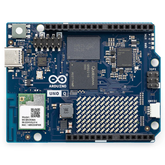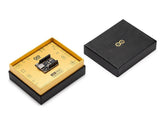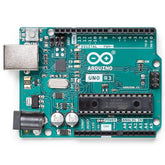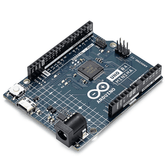Introduction to Arduino UNO Q: The Next-Gen Hybrid Board
Summary
The world of electronics and embedded systems is constantly evolving, and Arduino has always been at the forefront of this revolution.
With the launch of the UNO Q, enthusiasts, educators, and professionals alike have found a new reason to celebrate.
This next-gen Arduino board represents a significant leap forward, combining the reliability of traditional microcontroller boards with modern processing capabilities, making it a true hybrid Arduino board that bridges the gap between simplicity and advanced functionality.

What Is Arduino UNO Q and Why Everyone's Talking About It
The Arduino UNO Q is Arduino's latest offering for 2025, and it's generating considerable buzz in the maker community. Unlike its predecessors, this board isn't just an incremental update—it's a complete reimagining of what a development board can be.
The UNO Q functions as both a traditional microcontroller and a single board computer, giving users the flexibility to choose between lightweight embedded projects and more complex computational tasks.
What makes this hybrid microcontroller truly special is its dual-core architecture. One core handles real-time operations typical of Arduino projects, while the other manages higher-level computing tasks.
This architecture allows developers to run multiple processes simultaneously without compromising performance, making it ideal for both beginners learning the basics and professionals developing sophisticated IoT applications.
The timing of this release couldn't be better. As the Internet of Things continues to expand and edge computing becomes more prevalent, there's a growing need for boards that can handle both sensor interfacing and data processing locally.
The new Arduino UNO board 2025 addresses this need perfectly, positioning itself as the go-to choice for modern embedded system development.
Key Features of Arduino UNO Q

The UNO Q features represent a significant advancement in development board technology. Here's what sets this board apart:
Processing Power and Architecture
The UNO Q boasts a dual-core processor configuration, with one ARM Cortex-M4 core running at 120 MHz for real-time operations and one ARM Cortex-A7 core at 1 GHz for general computing.
This setup allows the board to execute complex algorithms while maintaining precise timing for sensor readings and actuator control.
Connectivity Options
Modern DIY projects demand robust connectivity, and the Arduino UNO Q connectivity options deliver exactly that. The board includes built-in Wi-Fi 6 and Bluetooth 5.2, eliminating the need for external shields for wireless communication.
Additionally, it features USB-C for programming and power, Ethernet support, and even optional LoRaWAN connectivity for long-range IoT applications.
Memory and Storage
With 512 MB of RAM and 4 GB of eMMC storage, the UNO Q can handle data-intensive applications that would overwhelm traditional Arduino boards.
This expanded memory makes it suitable for AI or machine learning applications at the edge, local data logging, and running multiple simultaneous processes.
Enhanced I/O Capabilities
The UNO Q pinout maintains backward compatibility with the classic UNO form factor while adding advanced features of Arduino UNO Q like additional analog inputs with higher resolution (16-bit ADC), more PWM channels, and dedicated hardware serial ports.
This means your existing shields and sensors will work seamlessly while giving you room to grow.
Specifications of Arduino UNO Q
Understanding the Arduino UNO Q microcontroller specs helps you appreciate what this board can accomplish:
Core Specifications
- Primary Processor: ARM Cortex-M4 @ 120 MHz (real-time operations)
- Secondary Processor: ARM Cortex-A7 @ 1 GHz (general computing)
- Operating Voltage: 3.3V logic with 5V tolerant pins
- Input Voltage: 7-12V DC via barrel jack or 5V via USB-C
- RAM: 512 MB DDR3
- Flash Storage: 4 GB eMMC
- Digital I/O Pins: 28 (14 with PWM capability)
- Analog Input Pins: 8 (16-bit resolution)
- Communication Interfaces: USB-C, UART x3, I2C x2, SPI x2
Wireless and Networking
- Wi-Fi: 802.11ax (Wi-Fi 6), 2.4 GHz and 5 GHz dual-band
- Bluetooth: 5.2 with BLE
- Ethernet: 10/100 Mbps with PoE support
- Optional: LoRaWAN module slot
Physical Characteristics
- Dimensions: 68.6 mm x 53.4 mm (standard UNO form factor)
- Weight: 35 grams
- Operating Temperature: -40°C to +85°C
Arduino UNO Q vs UNO R3 vs UNO R4
| Feature | Arduino UNO Q | Arduino UNO R4 | Arduino UNO R3 |
|---|---|---|---|
| Processor | Dual-core (M4 + A7) | Single-core ARM Cortex-M4 | ATmega328P |
| Clock Speed | 120 MHz + 1 GHz | 48 MHz | 16 MHz |
| RAM | 512 MB | 32 KB | 2 KB |
| Flash Storage | 4 GB eMMC | 256 KB | 32 KB |
| Operating Voltage | 3.3V | 5V | 5V |
| Built-in Wi-Fi | Yes (Wi-Fi 6) | Yes (Wi-Fi 4) | No |
| Bluetooth | 5.2 with BLE | No | No |
| Analog Resolution | 16-bit | 12-bit | 10-bit |
| USB | USB-C | USB-C | USB-B |
| Price Range | Premium | Mid-range | Budget-friendly |
The difference between Arduino UNO Q and Arduino UNO R4 is substantial. While both are modern boards, the UNO Q's dual-core architecture and significantly enhanced memory make it suitable for applications that the R4 simply cannot handle.
The Arduino UNO Q vs UNO R3 comparison is even more dramatic, with the Q offering over 200 times more RAM and processing power that's exponentially greater.
Arduino UNO Q vs Raspberry Pi 5 2GB
| Feature | Arduino UNO Q | Raspberry Pi 5 2GB |
|---|---|---|
| Architecture | Hybrid (MCU + SBC) | Full computer (SBC) |
| Processor | Dual ARM cores | Quad-core ARM Cortex-A76 |
| Clock Speed | 120 MHz + 1 GHz | 2.4 GHz |
| RAM | 512 MB | 2 GB |
| Real-time Operations | Excellent | Limited |
| GPIO Pins | 28 digital, 8 analog | 40 digital only |
| Power Consumption | Low (under 5W) | Moderate (15W typical) |
| Operating System | Arduino OS / bare metal | Linux required |
| Programming | Arduino IDE, C++, Python | Any language |
| Boot Time | Instant | 30–60 seconds |
| Built-in ADC | Yes (16-bit) | No |
| Price | Similar | Similar |
| Best For | Embedded systems, IoT, robotics | Desktop computing, media centers |
As you can see from the comparison, while the Raspberry Pi 5 is more powerful for general computing, the Arduino UNO Q excels in embedded applications where real-time control, low power consumption, and direct hardware interfacing are critical.
For best Arduino board for robotics applications, the UNO Q's hybrid nature gives it a distinct advantage.
What is Arduino App Lab?
Arduino App Lab is Arduino's revolutionary cloud-based development environment designed specifically for the latest Arduino release 2025 boards.
Think of it as the evolution of the traditional Arduino IDE, but with modern features that reflect how developers work today.
Rather than installing software locally, Arduino App Lab runs entirely in your web browser, providing a seamless experience across devices.
This platform goes beyond simple code editing. It integrates device management, over-the-air updates, visual programming tools, and collaborative features into one unified interface.
For educators teaching Arduino concepts, students learning embedded systems, or teams building commercial products, App Lab eliminates many traditional barriers to getting started with microcontroller development.
The platform leverages Arduino's cloud infrastructure to store your code, manage your devices remotely, and even deploy firmware updates to boards in the field.
This makes it particularly valuable for IoT projects where you might have devices deployed in multiple locations.
Key Features of Arduino App Lab

Browser-Based Development Environment
No installation required—simply open your browser and start coding. The Arduino IDE setup for UNO Q becomes as simple as logging into your account.
The environment includes intelligent code completion, syntax highlighting, and built-in debugging tools that work seamlessly with the Arduino UNO Q.
Visual Programming Interface
For beginners or rapid prototyping, App Lab offers a block-based programming mode. Drag and drop functional blocks to create programs without writing a single line of code.
Once comfortable, you can switch to text-based coding and even view the generated C++ code to learn how it works.
Over-the-Air Updates
Deploy firmware updates to your connected Arduino UNO Q boards remotely. This is particularly useful for projects deployed in hard-to-reach locations or when managing multiple devices simultaneously. The platform handles version control and rollback automatically.
Device Management Dashboard
Monitor all your connected boards from a single interface. View real-time status, check connectivity, manage permissions, and organize projects across multiple devices. This makes scaling from one prototype to dozens of deployed units straightforward.
Collaborative Features
Share robotic projects with team members, provide different access levels, and work simultaneously on the same codebase.
App Lab tracks changes and maintains version history, making it suitable for educational environments and professional development teams.
Integrated Libraries and Resources
Access thousands of community-contributed libraries directly through the interface. Search, install, and update libraries with a single click, eliminating the manual download and installation process.
How to Connect Arduino UNO Q with the Arduino App Lab

Getting started with Arduino UNO Q and App Lab is straightforward. Follow this Arduino UNO Q setup guide to establish the connection:
Initial Setup
Connect your Arduino UNO Q to your computer using the USB-C cable. The board will power on automatically. Navigate to app.arduino.cc in your web browser and create an Arduino account if you don't already have one.
Device Registration
Once logged in, click "Add Device" from the dashboard. The platform will automatically detect your connected Arduino UNO Q board.
Follow the on-screen prompts to register the device with your account. This process creates a secure connection between your board and the cloud platform.
Configure Network Settings
For wireless operation, you'll need to configure the board's Wi-Fi credentials. App Lab provides an intuitive interface to enter your network SSID and password. The board will then establish an internet connection, allowing remote programming and monitoring.
First Program Upload
Open the built-in examples and select "Blink" to test your setup. The familiar LED blink program demonstrates that your Arduino UNO Q is communicating properly with App Lab. Click "Upload" and watch as the code compiles in the cloud and transfers wirelessly to your board.
Advanced Configuration
Explore the settings panel to enable features like automatic firmware updates, remote debugging, and data logging. Set up webhooks to integrate your Arduino UNO Q projects with other cloud services like IFTTT or your custom APIs.
Is Arduino UNO Q the Future of Development Boards
The question isn't whether the Arduino UNO Q represents the future, but rather how quickly this future will arrive. This board addresses several critical trends in embedded system development that are reshaping the industry.
Convergence of MCU and SBC Capabilities
The traditional divide between microcontrollers and single-board computers is becoming less relevant. Modern applications often require both real-time control and computational power.
The hybrid Arduino board architecture of the UNO Q eliminates the need to use separate boards for different aspects of a project, reducing complexity, cost, and power consumption.
Edge Computing Requirements
As IoT devices become more sophisticated, there's growing demand for local processing rather than sending all data to the cloud.
The Arduino UNO Q provides sufficient computational power for edge AI inference, data preprocessing, and local decision-making while maintaining the low power consumption and reliability expected from embedded systems.
Educational Evolution
Students learning embedded systems need exposure to modern architectures and development practices. Starting with the UNO Q means learning skills that directly transfer to professional settings where hybrid boards and cloud-based development tools are becoming standard.
Maker Community Adoption
Early feedback from the maker community has been overwhelmingly positive. The best projects with Arduino UNO Q are already emerging, showcasing applications that would have required multiple boards or expensive specialized hardware just a year ago.
From autonomous drones to smart home controllers with local voice processing, the UNO Q is enabling a new generation of ambitious DIY projects.
The Arduino UNO Q hardware overview reveals a thoughtfully designed platform that respects Arduino's legacy of simplicity while embracing the complexity demanded by modern applications.
Whether you're learning how to program Arduino UNO Q for the first time or you're a seasoned developer pushing the boundaries of what's possible, this board scales to meet your needs.
Where to Buy Arduino UNO Q
Ready to experience the power of the next-gen Arduino board? Robocraze is your trusted destination for purchasing the Arduino UNO Q with complete confidence.
When you purchase your Arduino UNO Q from Robocraze, you're investing in reliable support and quality assurance. Every board comes with a comprehensive 6-month warranty, ensuring your investment is protected.
Our team of experts can guide you through selecting the right accessories and components for your specific project needs.
Robocraze offers not just the Arduino UNO Q itself, but also compatible shields, sensors, actuators, and project kits designed specifically for this board.
Build complete solutions without worrying about compatibility issues or sourcing components from multiple vendors.
Receive authentic Arduino products with fast, reliable shipping. Robocraze maintains extensive inventory, ensuring your Arduino UNO Q ships quickly so you can start building without delay.
Conclusion
The Arduino UNO Q marks a significant milestone in the evolution of development boards, seamlessly blending traditional microcontroller reliability with modern computing capabilities.
Its hybrid architecture, extensive connectivity options, and integration with Arduino App Lab position it as an ideal platform for today's demanding projects while remaining accessible to beginners.
Whether you're building IoT devices, robotics projects, or edge computing applications, the UNO Q provides the flexibility and power to bring your ideas to life with the simplicity that Arduino is known for.













